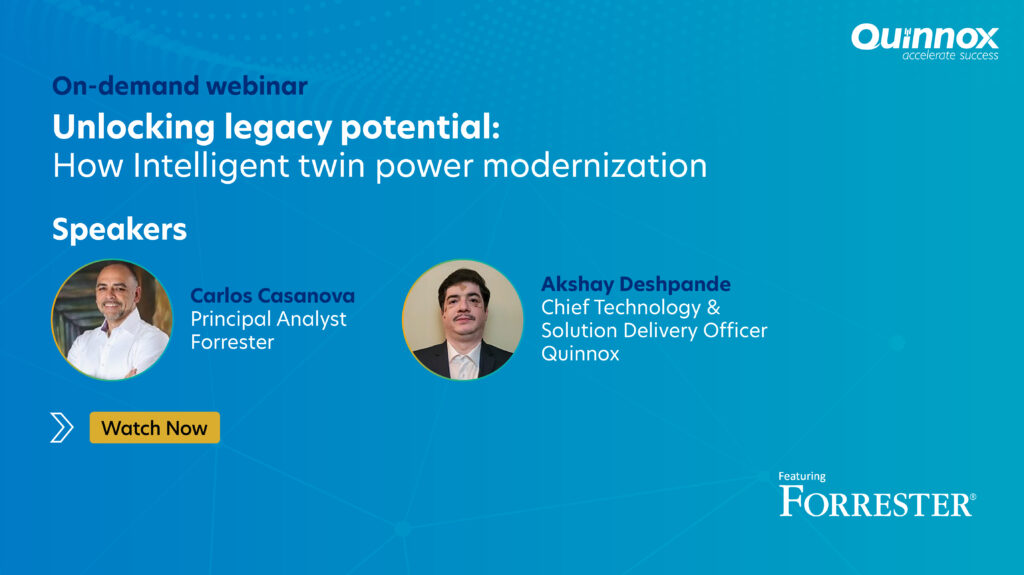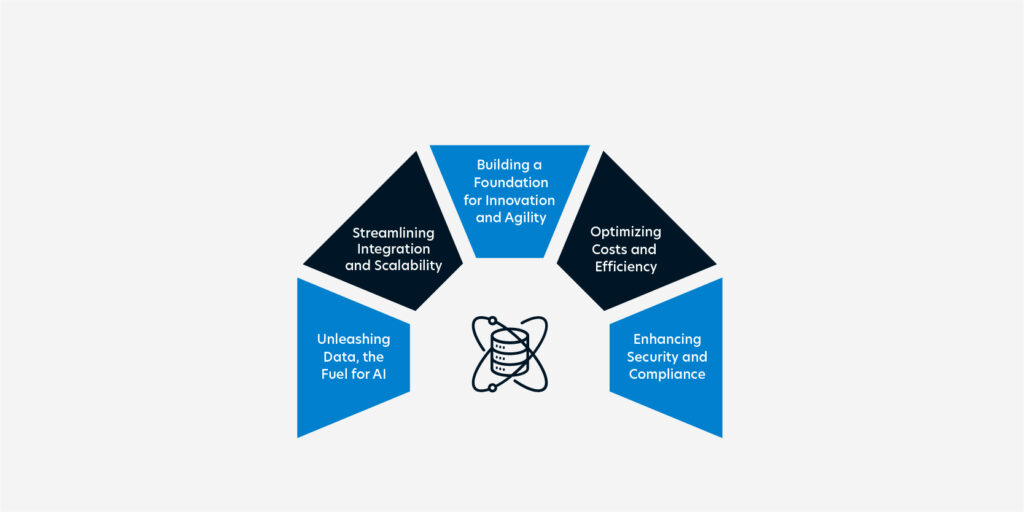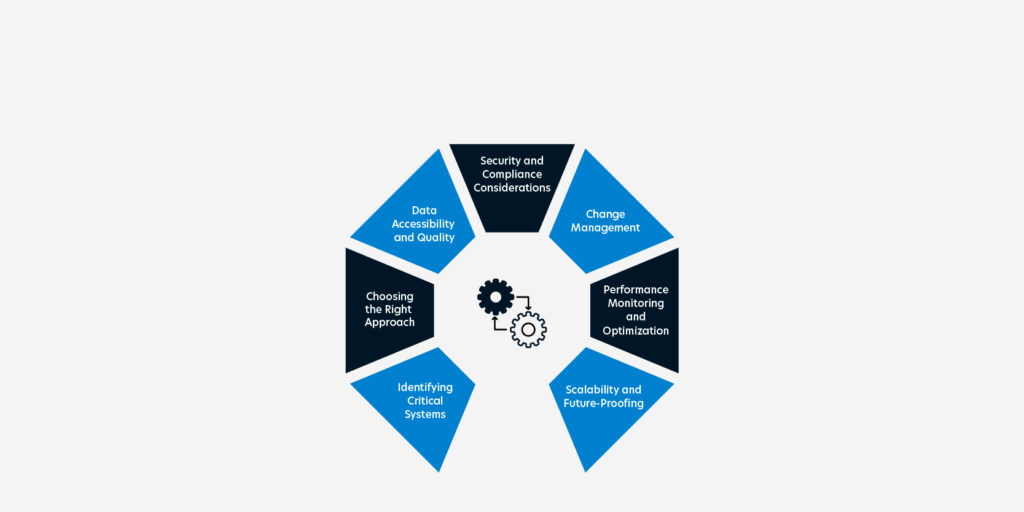Unlocking Legacy Potential: How Intelligent Twin Power Modernization
Watch on-demand webinar to get insights & strategies from Forrester analyst on how to navigate complexities of modernization
Read moreIn today’s competitive landscape, organizations are constantly seeking innovative ways to gain a competitive edge. Artificial intelligence (AI) has emerged as a powerful tool for optimization, automation, data-driven decision making and productivity. However, for many of them, the full potential of AI remains locked away due to a critical factor: legacy systems.
According to a 2022 study, more than 60% of companies are still in the experimental phase with AI, highlighting the significant impact of legacy systems on hindering the full integration of AI technologies.
These outdated software applications, be it your Mainframe systems, legacy ERPs, client-server, or custom build applications, often built years or even decades ago, hinder the seamless integration and utilization of AI solutions. Legacy modernization, the process of updating and transforming these systems, becomes an essential step in unlocking the true power of AI.
Watch this on-demand webinar to get expert insights and strategies from Forrester analyst on how to navigate the complexities of modernization and harness the power of AIOPs for transformative business outcomes


Embracing modern technologies like cloud computing, microservices architecture, AI, and advanced analytics becomes imperative to a future-proof reference architecture of an organization, minimizing any technical debt and keeping the technology landscape more composable.
1. Unleashing Data, the Fuel for AI:
Modern AI algorithms require vast amounts of clean, accessible data to function effectively. Legacy systems, however, often suffer from data silos, where information is fragmented and stored in incompatible formats across various applications. This makes it difficult to extract, integrate, and prepare data for AI models, hindering their ability to learn and generate accurate insights & content.
Legacy modernization solves this challenge by unlocking data accessibility. By migrating to modern systems with standardized data formats and robust data governance practices, companies can create a single source of truth, making data readily available for AI applications. This enables AI models to learn from a broader and more comprehensive dataset, leading to improved accuracy, efficiency, decision-making capabilities & producing relevant content.
2. Streamlining Integration and Scalability:
Integrating AI solutions with legacy systems can be a complex and time-consuming process. The outdated architecture and programming languages of legacy systems often create compatibility issues, hindering seamless integration and hampers the scalability of AI solutions.
Modernizing legacy systems facilitates smoother integration since these modern applications are built with open APIs (Application Programming Interfaces), cloud-native technologies and architectures, allowing for easier connection and communication with AI platforms. This allows businesses to quickly deploy and scale their AI solutions as their needs evolve.
3. Building a Foundation for Innovation and Agility:
Today’s rapidly changing business environment demands agility and adaptability. Legacy systems, most times become roadblocks to innovation, hindering the adoption of new technologies and adapt to evolving market trends.
Modernization lays the groundwork for future innovation. They are designed to be flexible and adaptable, allowing businesses to easily integrate new technologies, including future iterations of AI, as they emerge. This fosters a culture of innovation and equips companies to stay competitive in the ever-evolving landscape of AI and technology.
4. Optimizing Costs and Efficiency:
Maintaining legacy systems is often expensive. These systems require constant maintenance, patching, and updates, requiring dedicated IT resources and incurring significant costs. Additionally, their inefficient workflows and data silos contribute to wasted resources and hinder overall productivity.
Modern systems are designed for efficiency with automated processes, streamlined workflows, and reduced maintenance requirements. This frees up IT resources to focus on higher-value tasks and leads to cost savings in the long run.
5. Enhancing Security and Compliance:
Legacy systems are often vulnerable to cyberattacks due to outdated security protocols and lack of ongoing support. This poses a significant risk, especially when dealing with sensitive data utilized by AI models.
Legacy modernization addresses this threat by implementing robust security measures. Modern systems & cloud native technologies come equipped with enhanced security features, regular updates, and compliance with the latest security standards. This protects sensitive data and fosters trust with customers and partners who rely on the accuracy and security of AI-generated insights & content.

In conclusion, legacy modernization is not just an IT project; it’s a strategic investment in the future of your business. By unlocking the full potential of AI through streamlined data access, seamless integration, enhanced security, and a foundation for continuous innovation, companies can gain a significant competitive advantage. Legacy modernization is not a one-time solution but an ongoing process that ensures your business is continuously adapting and evolving to embrace the ever-changing power of AI.
Interested to know more about the critical significance of legacy modernization and how Quinnox can help in this journey of AI integration for successful modernization initiatives? Reach our experts today!
Watch on-demand webinar to get insights & strategies from Forrester analyst on how to navigate complexities of modernization
Read moreWelcome to our exclusive offer: a complimentary Forrester Advisory Session! Participate in this insightful session led by industry experts to unlock the strategic advantage your business needs.
Read moreModernizing legacy applications isn’t merely about keeping up with trends; it’s about unlocking business potential. The journey toward modernization promises improved efficiency, happier customers, and an edge over your competitors
Read moreGet in touch with Quinnox Inc to understand how we can accelerate success for you.